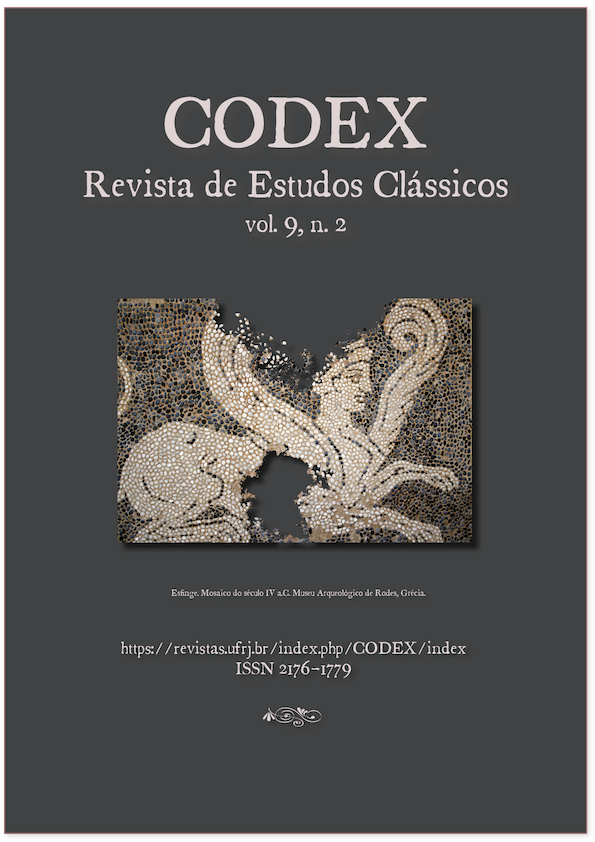Dionysian festivals in Attica: The City Dionysia
DOI:
https://doi.org/10.25187/codex.v9i2.44866Keywords:
festival, Ancient drama, Ancient religion, Dionysus, City DionysiaAbstract
This paper delineates a panorama of the festive and cultic context in honor of Dionysus in Attica (around Athens) during the celebration of the City Dionysia (also called the Great Dionysia or simply Dionysia). Its aim is to analyze the main ancient sources to the study of this context and to evaluate its possible relations with the later development of dramatic genres at the end of the archaic period. Working directly with the main testimonies and fragments at the disposal of anyone who wants to elucidate the details of this important festival to classical Athens’ history, some reflections about its common mythopoetic Dionysian basis are suggested.
References
Bibliografia primária
ARISTOPHANES. Aristophanis Comoediae. 2 Vol. Ed. F.W. Hall and W.M. Geldart. Oxford: Clarendon Press, 1907.
ARISTOPHANES. Aristophanis Comoediae. Cum Scholiis et varietate lectionis. Recensuit Immanuel Bekkerus. Vol. II. Londini: Sumtibus Whittaker, Treacher, et Arnot, 1829.
PAUSANIAS. Pausaniae Graeciae Descriptio. 3 vols. Leipzig: Teubner, 1903.
ARISTOPHANES. Pausanias’ Description of Greece. With an English Translation by W. H. S. Jones and H. A. Ormerod in 4 Volumes. Cambridge; London: Harvard University Press; William Heinemann, 1918.
SNELL, Bruno (ed.). Tragicorum Graecorum Fragmenta. Vol. 1: Didascaliae tragicae, catalogi tragicorum et tragoediarum, testimonia et fragmenta tragicorum minorum. Göttingen: Vandehoeck & Ruprecht, 1971.
Bibliografia secundária
BACELAR, Agatha Pitombo. Pégase d’Eleuthères: d’une légende de transmission tardive au mythe étiologique « re-enacted ». Codex, v. 1, n. 2 (2009), p. 145-65. DOI: https://doi.org/10.25187/codex.v1i2.2839
BURKERT, Walter. Griechische Religion der archaischen und klassischen Epoche. Zweite, überarbeitete und erweiterte Auflage. Stuttgart: Verlag W. Kohlhammer, 2011 [1977].
CONNOR, W. R. Tribes, Festivals and Processions: Civic Ceremonial and Political Manipulation in Archaic Greece. The Journal of Hellenic Studies. Vol. 107 (1987), p. 40-50.
CONNOR, W. R. City Dionysia and Athenian Democracy. Classica et Medievaelia, vol. XL (1989), p. 7-32.
CSAPO, Eric. Riding the phallus for Dionysus: Iconology, ritual, and gender-role de/construction. Phoenix, vol. 51, 3-4 (1997), p. 253-95.
DABDAB TRABULSI, José Antonio. Dionisismo, poder e sociedade na Grécia até o fim da época clássica. Belo Horizonte: Humanitas; Editora UFMG, 2004 [1990].
GOLDHILL, Simon. The Great Dionysia and Civic Ideology. The Journal of Hellenic Studies, v. 107 (1987), p. 58-76.
LAUGHY, Michael Harold. Ritual and Authority in Early Athens. 2010. 314f. Tese (Doutorado em Filosofia) – Ancient History and Mediterranean Archaeology in the Graduate Division of the University of California, Berkeley, 2010.
MALHADAS, Daisi. As Dionisíacas urbanas e as representações teatrais em Atenas. In: IVO, Oscarino da Silva; Santos, Rubens dos; MAFRA, Johnny José. Ensaios de Literatura e Filologia. Vol. 4. Belo Horizonte: Publicações do Departamento de Letras Clássicas da Faculdade de Letras da Universidade Federal de Minas Gerais (1983/84), p. 67-79.
PICKARD-CAMBRIDGE, Sir Arthur. The Dramatic Festivals of Athens. 2nd Edition Revised by John Gould and D. M. Lewis. Oxford: Clarendon Press, 1995 [1953].
RHODES, P. J. Nothing to Do with Democracy: Athenian Drama and the Polis. The Journal of Hellenic Studies, Vol. 123 (2003), p. 104-19.
SEAFORD, Richard. Reciprocity and Ritual: Homer and Tragedy in the Developing City-State. Oxford: Clarendon Press, 1994.
SHRIMPTON, Gordon. When did Plataea Join Athens? Classical Philology, 79 (1984), p. 295-304.
SOURVINOU-INWOOD, Christiane. Tragedy and Athenian religion. Lanham; Boulder; New York; Oxford: Lexington Books, 2003.
WILSON, Peter. The Athenian Institution of the Khoregia: The Chorus, the City and the Stage. Cambridge: Cambridge University Press, 2000.
Downloads
Published
How to Cite
Issue
Section
License
This work is licensed under a Creative Commons Attribution-NonCommercial 4.0 International License.










